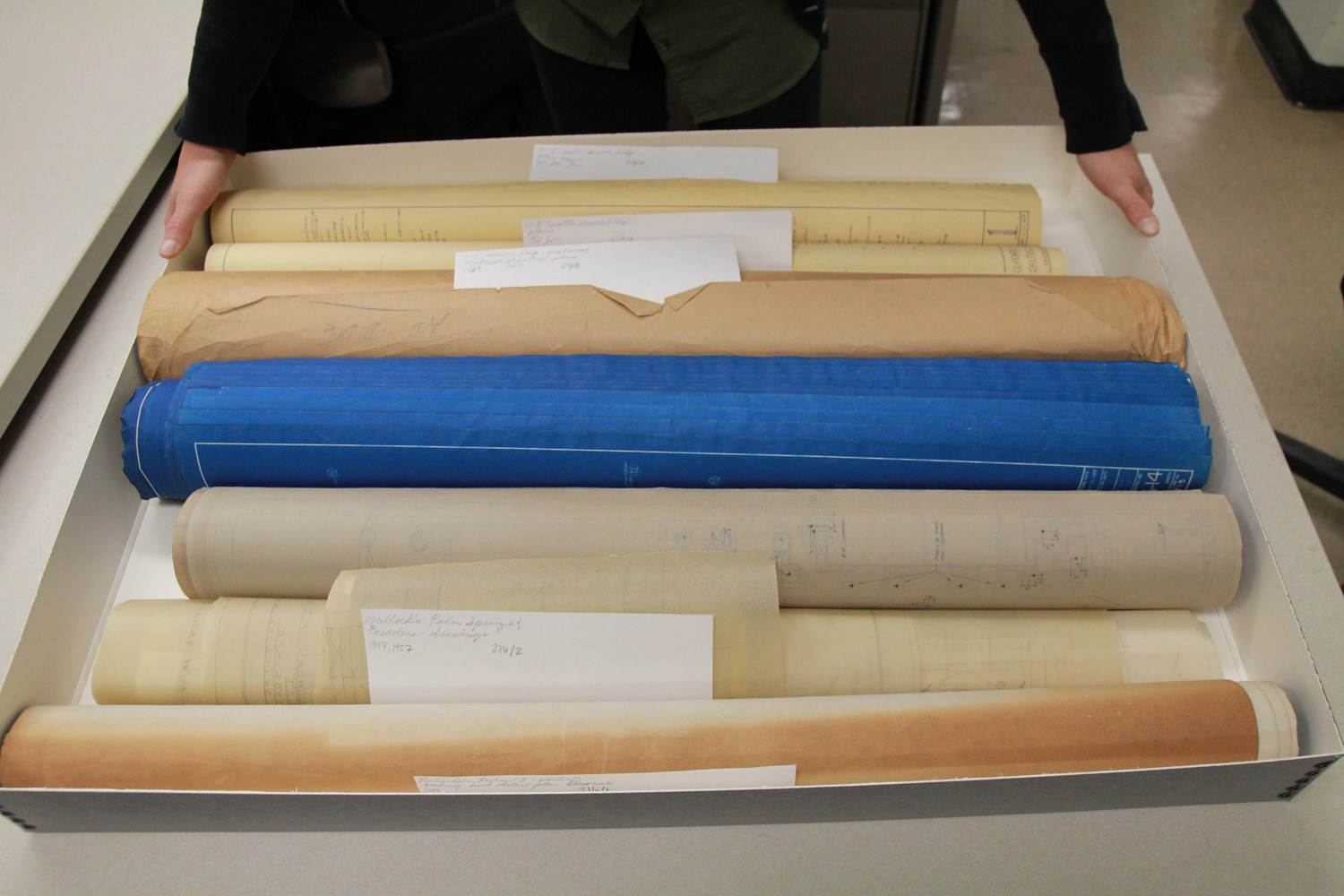I. Overview
Collection type:
Papers and drawings of landscape architect Ruth Shellhorn
Extent and scope:
82.5 linear feet, plus 134 rolled drawing boxes, 98 flat boxes, 17 shoe boxes, and 7 oversize specialty boxes. With the following series: business resources, client files, models, personal, photographs, plans and drawings, professional life, slides. The largest portion of this collection contains architectural drawings and client files.
Background:
The Ruth Shellhorn papers were accessioned shortly after her death in 2006. The UCLA Library submitted two different grant proposals to process the collection, which were not funded. We had initially estimated it would take a full time archivist 15 to 18 months to process the collection. The collection would have been processed in great detail, with all 4,100 of the drawings sorted and arranged and duplicates weeded. Given that we were unsuccessful in our attempts to fund the position through grant applications we decided on an alternate, more affordable approach, adopting some principles of minimal processing.
II. Approach
Before:
The collection included ca. 4,100 rolled plans, sketches and blueprints; plus 103 linear feet of papers, including client files, product files and samples, and project photographic prints and slides, correspondence, scrapbooks, clippings, and awards. The 4,100 plans, sketches and blueprints were rolled in bundles, with several items from one project rolled together, but were otherwise not organized. The 103 linear feet of papers were in labeled folders and well organized.
Instead of hiring an archivist, as was outline in our grant proposal, we hired a part-time graduate student in the Center for Primary Research and Training to process the collection.
During:
- Student processor surveyed the collection and determined the series: business resources, client files, models, personal, photographs, plans and drawings, professional life, and slides.
- She began the processing of the Client Files, which were well organized and straightforward to process. The materials were left in their original order, which was alphabetical by client name. They were not refoldered and description was based primarily on the original folder labels. Folders were placed in acid-free document boxes.
- The second series she processed was Plans and Drawings. In our initial grant proposal we had outlined a processing plan where the 4,100 plans and drawings would be flattened, sorted, and duplicates weeded, which would have been a very time consuming task. Instead, we opted for a simpler solution. Each roll contained multiple drawings that were rolled together, typically from one project. The processor did take the time to look through each roll to insure that all the drawings were from the same project. On occasion she would remove a drawing that was clearly out of place and set it aside to be described separately. The material was left rolled and placed in oversize flat boxes. On average one oversize flat box could hold 7 rolls. Each roll of multiple drawings was described as one unit, listing the project name. This series was sorted alphabetically in the finding aid, but was not physically rearranged. This approach saved a tremendous amount of time on the project.

4. The remaining series were smaller in size and the processing was fairly straightforward. The creator left her papers in good order. No sorting or weeding was done for the majority of the collection, except for sorting the photographs roughly by date. Material was described in the original order. All materials were put in acid free boxes, but no additional rehousing was done. The exceptions to this was some refoldering of the correspondence and slides were placed into slide sleeves.
After:
The EAD finding aid:
http://www.oac.cdlib.org/findaid/ark:/13030/kt5n39s1pg/?query=ruth%2520shellhorn
- The resulting finding aid is fairly detailed. The student processor even cross referenced the client files to the drawings.
- With the exception of the drawings, this collection was very well organized and straightforward to process, which made much of the work go quickly. For the majority of the papers the material was left in its original folder, material did not receive item level treatment, and description was based on what was written by the creator on the folder.
- The biggest time savings was with the drawings. By abandoning plans of itemized treatment, the work also went quickly.
- A researcher who is writing a biography on Ruth Shellhorn reviewed our front matter and suggested edits. As the researcher continues to work with the material, she will be submitting edits to the container list as well.
Use:
This collection has been heavily used by the researcher who is writing a biography on Ruth Shellhorn.
III. Processing rate:
Unknown. The processing was complete in a 9 month period by a student processor who was working 12-15 hours a week on the project.
IV. Pros and Cons
Pros:
- A significant amount of time was saved when processing the plans and drawings. They were not flattened or sorted. Groups of rolled drawings were simply boxed and the project name was used for the description. They were described in the order they came in. There are a lot duplicates in the collection, but no attempt was made to remove them.
- Existing folder level description was used and materials were left in their original order in original folders, making the processing of the papers go quickly. Because of existing description and good order, the finding aid description has more detail than you may expect of a minimally processed collection.
- No item level treatment.
Cons:
- The rolled plans and drawings will be difficult for patrons to use in the reading room, especially because there are bundles of multiple drawings rolled together. Some of them are original drawings on vellum or tracing paper, which is very fragile. Overtime the paper will likely become more brittle and may crack.
- Researchers may be frustrated by all the duplicates of drawings. They probably will need to page a lot of material to find what they are looking for and will likely have to look through a lot of duplicates.
Version 3.0. Last reviewed: August 20, 2012
